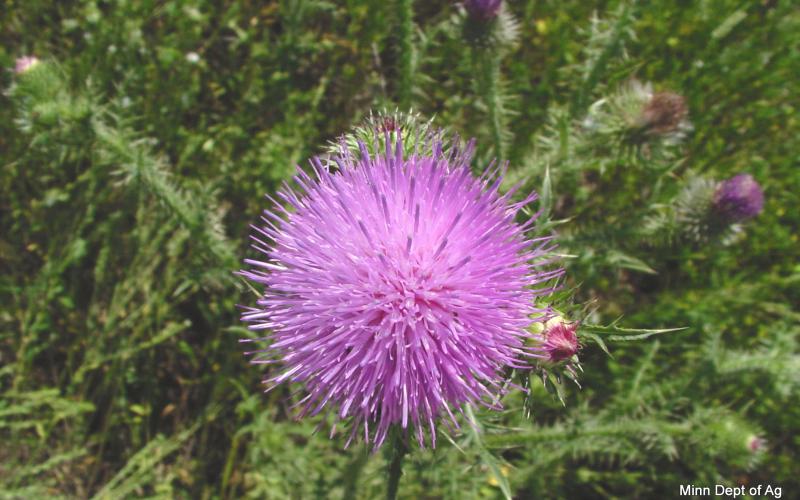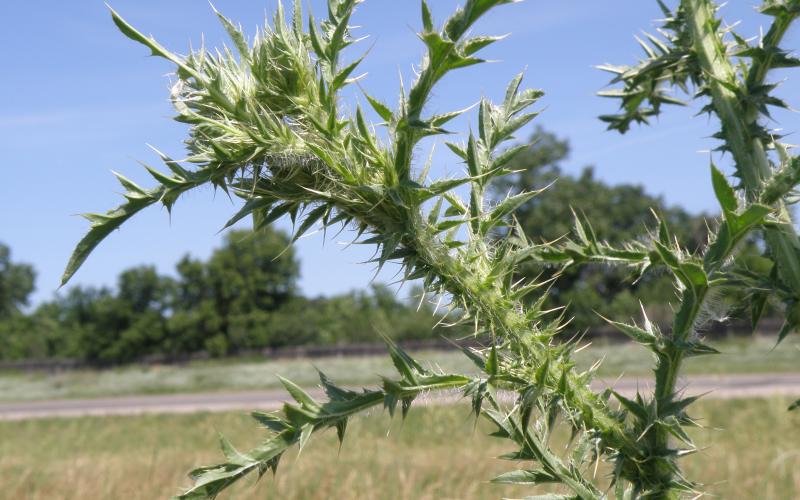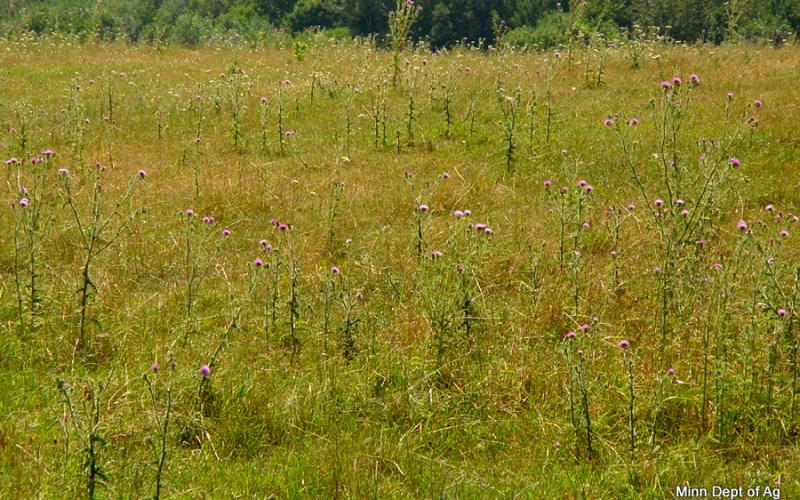Common Names: Plumeless Thistle, Spiny Plumeless Thistle
Scientific Name: Carduus acanthoides L.
Legal Status
Efforts must be made to prevent seed maturation and dispersal of plants into new areas. Additionally, no transportation, propagation, or sale of these plants is allowed. Failure to comply may result in enforcement action by the county or local municipality.
Background
Plumeless thistle is native to Europe in open grasslands and disturbed areas. It was introduced to North America in the 1870s and is widespread throughout Minnesota.
Description
- Plumeless thistle is a biennial species that reproduces by seed.
- It grows 3- 5 feet tall.
- The stems are branched and covered with numerous spiny leaves.
- The rosettes have deeply lobed, narrow, and spiny leaves.
- In the second year, the plant bolts, forming branched stems with alternate spiny-lobed leaves that are narrower and wavier than the closely related musk thistle and extend onto and around the stem, giving it the appearance of having clusters of leafy spines throughout.
- Flowers are small, purple to pink, singular or in clusters, and subtended by numerous needle-like bracts. The plant blooms on the end of stems mid-June to August and can be bulbous in shape.
Habitat
Plumeless thistle is found growing in a wide range of habitats, most commonly found in disturbed areas along road, trail, and railroad rights-of-way, pastures, rangeland, gravel pits, vacant lots, and field edges. It also aggressively invades natural areas and landscape restorations.
Means of spread and distribution
Plumeless thistle is commonly found throughout the western counties and northern half of the state with the largest populations in the central, north-central, and northwestern parts.
Impact
Plumeless thistle is highly invasive to disturbed habitats and can quickly replace desirable plants, creating large monocultures that significantly lessen the biological diversity and productivity of native landscapes. It is a common pasture weed that reduces the availability of desirable forages leading to the economic hardships for livestock producers.
Prevention and management
- Prevent flowering throughout the season to ensure seeds are not added to the seedbank. Over time the seedbank will become exhausted, allowing more desirable vegetation to establish.
- Prior to flowering, pull plants using protective gloves or dig up with a shovel if the infestation is small enough. Check the site regularly to remove re-sprouts and to destroy new seedlings.
- Mowing and cutting plants close to the ground will significantly reduce flowering and therefore, seed production. Repeat the effort throughout the season. This effort, over several years, is very effective in eliminating plant development, especially if grasses and forbs begin to establish. Wash equipment thoroughly following mowing to prevent seeds from spreading to new areas.
- Livestock producers can help prevent infestations by not overgrazing pastures and immediately eliminating any plants that appear. Large infestations are difficult to manage.
- Various herbicides are effective against this plant. If using herbicide treatments, check with your local University of Minnesota Extension agent, co-op, or certified landscape care expert for recommendations. Herbicide applications in the early spring and late fall produce good overall management results, especially if follow-up treatments in the fall or following spring are done to kill new seedlings or plants still alive after the initial application.
- Plumeless thistle lifecycle and treatment timing graphic





